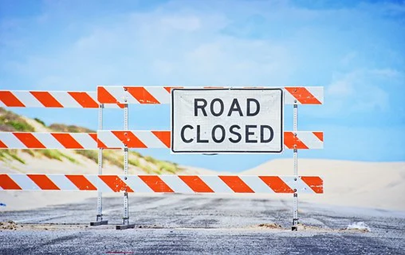Drift, Distraction and Discouragement – are three barriers standing in the way of where you want to go!
I’ve found that these 3DS happen across the board to leaders, managers, business owners and influencers continually taking them back to their default setting, stopping them from getting where they really want to go and making change in the world. The 3DS lurk in the life and leadership of many people, limiting how effective they can be. They’re hard to spot, and they can be very hard to break out from! So today, I’ll be introducing you to the 3DS, and how you can overcome them and harness your effectiveness as a leader- influencer in your organisation.
Drifting off course
What is drift? Well, it’s when you start out with a goal or objective in mind, but you find yourself heading way off course. You might make good progress in the right direction for awhile, but once you start to drift, even though you’re putting in effort, you won’t end up at your desired destination. Navigators know that if you’re sailing and you move away just one degree, within 100 miles you’ll be so off course that it will take many days to get back on-course. Drifting away from your original course setting doesn’t take much, but it can happen very easily – and all-too-often, you’ve gone many hundreds of metaphorical miles before you realise you’ve been heading in the wrong direction.
When leaders drift off course, it’s often towards an inner default setting that they tend to gravitate towards, and they find themselves returning to where they started even though they long to change and develop.
So, how can you combat drift? With focus! Focus is a discipline and strategy that you place in your life, your world, your practice, and your principles. It involves holding yourself accountable by asking yourself focus questions to help you determine, “Am I staying on track; am I staying the course?” There will be days when you find yourself drifting a little, because we’re only human, and progress isn’t always linear – but it’s better to make smaller course corrections sooner than find yourself back at square one.
The age of distractions
In today’s 24/7 world, distractions are all around us, all day, every day – and they’re very tempting. There’s an absolute kaleidoscope of things that can distract you and make you less effective – whether it’s an email, a notification, a telephone call, a staff member (or a family member) knocking on your door. Most of the distractions that enter into your world that are unplanned and unexpected.
Research demonstrates that it takes almost 25 minutes to refocus yourself after an involuntary distraction. Keep in mind, we’re talking about involuntary distractions; this isn’t the same as taking time to stretch your body, take a meditation break or a walk. Self-care is non-negotiable to keep you happy, healthy and bringing your best self to your work. But if someone’s popping into your office every half-hour to interrupt you, you’re not going to be able to work effectively.
Short of working in a writing hut like Roald Dahl or Virginia Woolf, it’s sometimes difficult to get peace and quiet enough to concentrate. When you’re working with other people, distractions happen, and when you’re working alone, there’s no-one to hold you accountable for your productivity but yourself.
Both of these scenarios come with their own challenges, and there’s some more obvious solutions: from the do-not-disturb sign on your office door and identifying where meetings should have been emails or vice-versa, to recognising that social media is specifically curated for addictiveness and even its top designers have been ringing alarm bells. But at a strategic level, what you’re looking for is a clarity of mind, which is vital to be successful. People will often place statements in front of them to remind them about what it is that they really are all about, helping them to spend their time more wisely. They’ll use tools and techniques to create clarity in their day, week, month, quarter and year, and in what’s going on for them in their lives, businesses, and the way they operate.
Discouragements: handling the bumps in the road
Discouragements come out of the blue, are often unexpected, and can hit us really, really hard. A staff member knocks on your door and says, “I’ve had enough, I’m out of here!” and takes an enormous body of knowledge with them. A supplier phones, “I’m putting up your prices 25%”. All sorts of discouragements can come; maybe you look at the invoicing out that you’ve done this month compared to last year, and start wondering where you’ve gone wrong. Maybe something personal hits you like a rock. Maybe it’s how a seismic shift in the way the world works effects you, as we’ve seen in the second year of the COVID-19 pandemic.
What do you do about this? Well, accountability is a personal and professional choice, which you and I need as leaders in our world. We have to create accountability mechanisms. I have one colleague to illustrate this; his accountability method is simply a notebook. He marks down what he needs to do for the day, in priority order, and just works through. If it’s not accomplished that day, it’s written up for the next day, and the day after that. His accountability is the discipline of doing that on a regular basis, accepting the things he cannot change, and recognising that a journey of a thousand miles begins with a single step. This is the important dynamic that we have to do as leaders in our world in creating accountability.
Changing your default setting
Our default is a setting that can be very limiting, and very resistant to change, particularly when faced with drift, distraction, and discouragements. Changing our default setting to be fresh, alive, powerful and dynamic involves bringing focus, clarity and accountability into our world. I know that you’re going to ask the question, “Yes, I get what you’re saying, but how do I do that?” This is the power of having a coach in your world, because he or she walks alongside you, helps to empower you as you grow personally and professionally, and asks you the vitally important questions in these areas to help you understand whether you’re drifting, distracted, or discouraged, and how to get back on track. Getting back to what you know you’ve said you want to do and accomplish; helping you get stuck back into doing that; and remembering why you want to get there in the first place. What a difference that that will make in your world as you become everything you’re capable of. Dealing better with these 3DS sets a new default patternfor your life, and helps you set an example for others as you mentor them in their own journeys towards becoming effective leaders in their worlds.
By John Hardy




It was an eye opener that it takes 25 minutes to get back on track after a distraction, and there are so many of them. It was a good reminder to keep all distractions out of the workplace until you are done. And if some are unavoidable to be aware that it can take time to refocus and learn to grow through this.
thanks for your insight